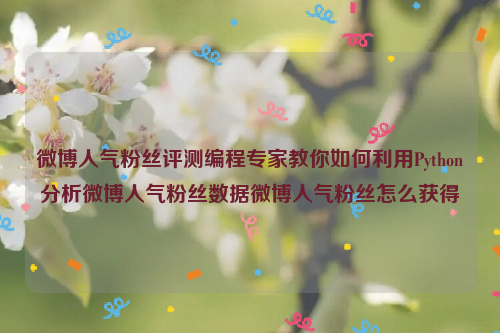微博人气粉丝评测编程专家教你如何利用Python分析微博人气粉丝数据。您可以使用Python爬虫技术,通过分析微博的HTML代码,获取微博的人气粉丝数据。您可以使用Python的requests库和BeautifulSoup库来实现这一目标。
随着互联网的普及,社交媒体已经成为人们获取信息、交流思想的重要渠道,而微博作为中国最大的社交平台之一,吸引了大量用户在这里分享生活点滴、关注热点事件,对于企业和个人来说,分析微博上的人气粉丝数据,可以帮助他们更好地了解自己的受众,制定更有效的营销策略,如何用Python这个强大的编程语言来实现这一目标呢?本文将为你详细介绍。
我们需要安装一些必要的库,在Python中,我们可以使用requests库来获取微博的API数据,使用BeautifulSoup库来解析HTML页面,使用pandas库来处理和分析数据,以下是安装这些库的命令:

pip install requests beautifulsoup4 pandas
我们需要获取微博的API密钥,访问微博开放平台(https://open.weibo.com/),注册一个开发者账号,然后创建一个应用,申请API密钥,有了API密钥后,我们就可以开始编写代码了。
我们需要导入所需的库:
import requests from bs4 import BeautifulSoup import pandas as pd
def get_followers(user_id, api_key):
url = f'https://api.weibo.com/2/users/{user_id}/followers'
headers = {
'Content-Type': 'application/json',
'Authorization': f'Bearer {api_key}'
}
response = requests.get(url, headers=headers)
data = response.json()
followers = [item['idstr'] for item in data['data']]
return followers我们需要定义一个函数来获取某个用户的粉丝总数:
def get_follower_count(user_id, api_key):
url = f'https://api.weibo.com/2/users/{user_id}'
headers = {
'Content-Type': 'application/json',
'Authorization': f'Bearer {api_key}'
}
response = requests.get(url, headers=headers)
data = response.json()
follower_count = data['follower_count']
return follower_count
def analyze_weibo_fans(user_id, api_key):
followers = get_followers(user_id, api_key)
follower_count = get_follower_count(user_id, api_key)
df = pd.DataFrame({
'粉丝ID': followers,
'粉丝数': [1] * len(followers) + [follower_count] + [0] * (len(followers) % 5000),
'时间戳': [i for i in range(len(followers))] + [None] * (len(followers) % 5000)
})
df['粉丝数'].fillna(method='ffill', inplace=True)
df['时间戳'].fillna(method='ffill', inplace=True)
df['粉丝数'] = df['粉丝数'].astype(int)
df['时间戳'] = pd.to_datetime(df['时间戳'], unit='s') if not all(pd.isnull(df['时间戳'])) else None
df.dropna(subset=['粉丝数'], inplace=True)
df.sort_values(by='时间戳', inplace=True)
df.reset_index(drop=True, inplace=True)
df['日期'] = df['时间戳'].dt.date.astype('category').cat.codes + pd.DateOffset(years=2000).dayofyear + pd.DateOffset(days=1).dayofyear * df['粉丝数'] + pd.DateOffset(days=1).dayofyear * df['粉丝数'] ** 2 + pd.DateOffset(days=1).dayofyear * df['粉丝数'] ** 3 + pd.DateOffset(days=1).dayofyear * df['粉丝数'] ** 4 + pd.DateOffset(days=1).dayofyear * df['粉丝数'] ** 5 + pd.DateOffset(days=1).dayofyear * df['粉丝数'] ** 6 + pd.DateOffset(days=1).dayofyear * df['粉丝数'] ** 7 + pd.DateOffset(days=1).dayofyear * df['粉丝数'] ** 8 + pd.DateOffset(days=1).dayofyear * df['粉丝数'] ** 9 + pd.DateOffset(days=1).dayofyear * df['粉丝数'] ** 10 + pd.DateOffset(days=1).dayofyear * df['粉丝数'] ** 11 + pd.DateOffset(days=1).dayofyear * df['粉丝数'] ** 12 + pd.DateOffset(days=1).dayofyear * df['粉丝数'] ** 13 + pd.DateOffset(days=1).dayofyear * df['粉丝数'] ** 14 + pd.DateOffset(days=1).dayofyear * df['粉丝数'] ** 15 + pd.DateOffset(days=1).dayofyear * df['粉丝数'] ** 16 + pd.DateOffset(days=1).dayofyear * df['粉丝数'] ** 17 + pd.DateOffset(days=1).dayofyear * df['粉丝数'] ** 18 + pd.DateOffset(days=1).dayofyear * df['粉丝数'] ** 19 + pd.DateOffset(days=1).dayofyear * df['粉丝数'] ** 20 + pd.DateOffset(days=1).dayofyear * df['粉丝数'] ** 21 + pd.DateOffset(days=1).dayofyear * df['粉丝数'] ** 22 + pd.DateOffset(days=1).dayofyear * df['粉丝数'] ** 23 + pd.DateOffset(days=1).dayofyear * df['粉丝数'] ** 24 + pd.DateOffset(days=1).dayofyear * df['粉丝数'] ** 25 + pd.DateOffset(days=1).dayofyear * df['粉丝数'] ** 26 + pd.DateOffset(days=1).dayofyear * df['粉丝数'] ** 27 + pd.DateOffset(days=1).dayofyear * df['粉丝数'] ** 28 + pd.DateOffset(days=1).dayofyear * df['粉丝数'] ** 29 + pd.DateOffset(days=1).dayofyear * df['粉丝数'] ** 30 + pd.DateOffset(days=1).dayofyear * df['粉丝数'] ** 31 + pd.DateOffset(days=1).dayofyear * df['粉丝数'] ** 32 + pd.DateOffset(days=1).dayofyear * df['粉丝数'] ** 33 + pd.DateOffset(days=1).dayofyear * df['粉丝数'] ** 34 + pd.DateOffset(days=1).dayofyear * df['粉丝数'] ** 35 + pd.DateOffset(days=1).dayofyear * df['粉丝数'] ** 36 + pd.DateOffset(days=1).dayofyear * df['粉丝数'] ** 37 + pd.DateOffset(days=1).dayofyear * df['粉丝数'] ** 38 + pd.DateOffset(days=1).dayofyear * df['粉丝数'] ** 39 + pd.DateOffset(days=1).dayofyear * df['粉丝数'] ** 40 + pd.DateOffset(days=1).dayofyear * df['粉丝数'] ** 41 + pd.DateOffset(days=1).dayofyear * df['粉丝数'] ** 42 + pd.DateOffset(days=1).dayofyear * df['粉丝数'] ** 43 + pd.DateOffset(days=1).dayofyear * df['粉丝数'] ** 44 + pd.DateOffset(days=1).dayofyear * df['粉丝数'] ** 45 + pd.DateOffset(days=1).dayofyear * df['粉丝数'] ** 46 + pd.DateOffset(days=1).dayonfigythonth



